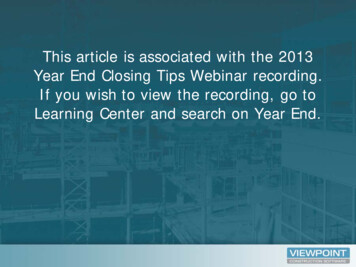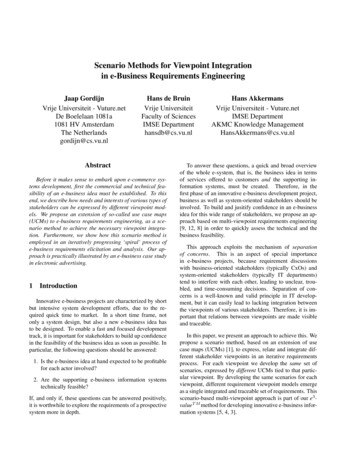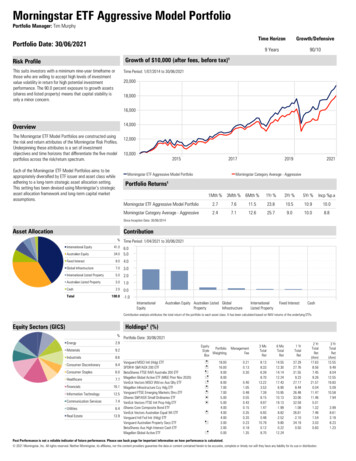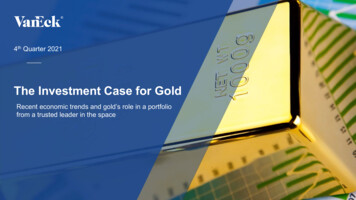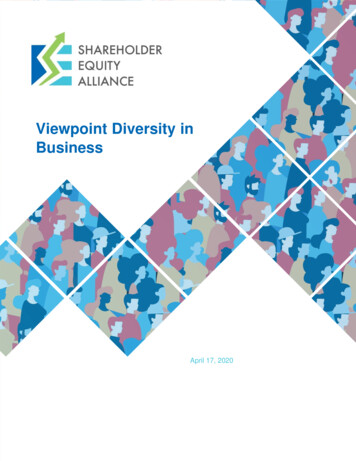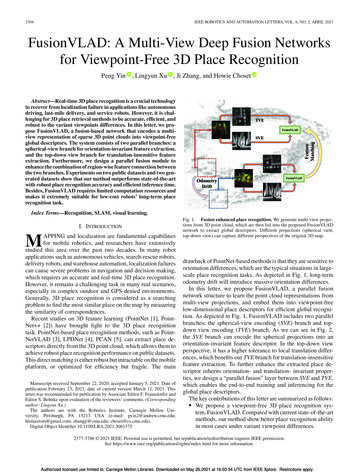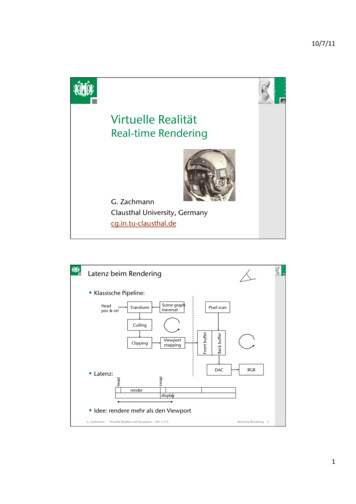
Transcription
VanEck ViewPoint The soft or hard landing calamityVanEckViewPointATMThe soft or hard landing calamityJune 2022
VanEck ViewPoint The soft or hard landing calamityChina EquitiesGold9.04%2.08%Australian Bank BillsUK Equities0.07%-1.21%EM Equities-2.22%Australian Fixed IncomeEuropean Equities-4.03%-5.09%Global Fixed IncomeEM Fixed Income-5.52%-6.17%Japanese Equities-6.29%Global EquitiesUS Equities-7.44%-7.69%USA Small CapsAustralian Equities-9.08%-10.13%Australian Small CapsThese are the times, it’s a first in three decades. The inflation conundrum can’t be solvedwith crude monetary policy, it is however the only instrument in the current central banktoolkit. Supply induced inflation can only be offset by a significant reduction in demand.Economies are over-heating and capacity constraints are felt across the board. A softlanding narrative seems far from the truth but the debate continues. Central bankersare optimistic but there is a dislocation with market pricing. Someone is right, someoneis wrong. Throughout history, a lesson for investors is, don’t fight the Fed. The Fed,unequivocally, has its eye on inflation. Investors should not discount this. The “Fed Put”isn’t coming to the rescue anytime soon and markets are adapting, quickly, to this reality.-18.96%-0.25-0.2-0.15-0.1-0.0500.05Chart 2: Global and Australian equity sectors quarterly performanceAustralia“For those properly prepared, the bear market is not onlya calamity but an opportunity.”John Templeton4.78%50.96%0-0.39%%-10-15 11.68%-15.58%-15.55%-20-25Health CareUtilitiesReal ionaryWhile we are not at the point of despair investors are feeling the bear market blues. Bearmarkets don’t last forever. They are normal and part of a normal cycle. Since 1928 bearmarkets have tended to be short-lived with the average length being 289 days or justover 9.5 months. The question of reaching the peak or trough is a perpetual one and noinvestor has ever picked either. These markets present opportunities.0.15Source: Bloomberg, 1 April 2022 to 29 June 2022, returns in Australian dollars. US Equities is S&P 500 Index, International Equities isMSCI World ex Australia Index, European Equities is MSCI Europe Index, UK Equities is FTSE 100 Index, Australian Equities is S&P/ASX 200Accumulation Index, Australian Small Caps is S&P/ASX Small Ordinaries Index, Gold is Gold Spot US /oz, USA Small Caps is Russell 2000Index, China Equities is CSI 300 Index, Global Fixed Income is Bloomberg Global Aggregate Bond Hedged AUD Index, Australian BankBills is Bloomberg AusBond Bank Bill Index, Australian Fixed Income is Bloomberg AusBond Composite 0 yrs Index, EM Fixed Incomeis 50% J.P. Morgan Emerging Market Bond Index Global Diversified Hedged AUD and 50% J.P. Morgan Government Bond-EmergingMarket Index Global Diversified, EM Equities is MSCI Emerging Markets Index, Japanese Equities is Nikkei 225 Index. Past performanceis not a reliable indicator of future performance.10For Australian investors, 2022 has so far been a tale of two halves. Australian equitiesrallied into the commodity momentum and then pivoted to a steep and sharp drawdown.Australian equities went from the best performing equity market in quarter one, to be theworst in quarter two. On the flipside the worst performer in quarter one, China A-shares,is now the best performer in quarter two. Reflecting the rising rate environment, energywas the best performer globally. Locally, utilities which include energy followed the trend.0.1EnergyBond investors are experiencing the same return phenomena as their equity counterparts.The widely used Australian Fixed Interest benchmark, the Bloomberg Australian BondComposite, has experienced a total drawdown in excess of 11%. Investors are learning ahard lesson in duration. One that has not been experienced since 1994.Chart 1: Mainstream asset class returns for the quarterConsumerStaplesThe era of easy money ebullience is over. Profitless technology is a liability. Equityinvestors are experiencing the first sustained drawdown in 10 years. The current bearmarket has lasted seven months with the technology, growth proxy Nasdaq 100 peakingon 19th November 2021. Private markets are feeling the pain too as institutionalinvestor’s mark-to-market their venture capital investments. Financial conditions aretightening, with no place to hide.1Source: Bloomberg, 1 April 2022 to 29 June 2022, returns in Australian dollars. Utilities is MSCI World Utilities Index / S&P/ASX 200Utilities Index, Industrials is MSCI World Industrials Index / S&P/ASX 200 Industrials Index, Materials is MSCI World Materials Index / S&P/ASX 200 Materials Index, Consumer Staples is MSCI World Consumer Staples Index / S&P/ASX 200 Consumer Staples Index, ConsumerDiscretionary is MSCI World Consumer Discretionary Index / S&P/ASX 200 Consumer Discretionary Index, Financials is MSCI WorldFinancials Index / S&P/ASX 200 Financials Index, Energy is MSCI World Energy Index / S&P/ASX 200 Energy Index, Healthcare is MSCIWorld Heath care Index / S&P/ASX200 Heath care Index, Telecommunications is MSCI World Telecommunications Index / S&P/ASX 200Telecommunications Index, Information Technology is MSCI World Information Technology Index / S&P/ASX 200 Information TechnologyIndex, Real Estate is MSCI World REIT Index / S&P/ASX 200 AREIT Index. Past performance is not a reliable indicator of future performance.
VanEck ViewPoint The soft or hard landing calamityChart 3: It’s not just supply issuesUS inflation compositionIt feels like it’s been a long time, waiting for markets to adjust to a new reality. But theserious and long-lasting nature of macro issues seems to be finally sinking in.No one could know in advance how COVID-19 would pan out. However, as we emergedfrom lockdowns, massive waves of stimulus saw economies rapidly get back on their feet.A disconnect between markets and reality was the result.AmbiguousSupply43%21Responding to a supply contraction with a demand boost leads to higher prices. It iseconomics 101. Yet, to this day, people seem mystified about where inflation came from.0Sceptics are still trotting out the line that, since the problems are supply side, and thereforewill not be fixed by lowering demand, the authorities should not squeeze demand.Jun 21Apr 22Oct 19Aug 20Feb 18Dec 18Jun 16Apr 17Oct 14Aug 15Dec 13Apr 12Feb 13Jun- 11Oct 09Aug 10Feb 08Dec 08Jun 06Apr 07Oct 04Aug 05Feb 03Dec 03Jun 01Apr 02Dec 98-1Oct 99To be fair, markets were not the only ones that missed the boat. Policy makers, like manya general, were busy fighting the last war, in this case, the GFC. However, the GFC was aliquidity and demand destruction event, COVID-19 was a temporary demand destructionevent accompanied by a whopping supply-side problem.Demand5Aug 00Are we there yet?2The truth is, the inflation problem comes from both supply and demand and the interactionbetween the two. So, it’s pointless, and likely to prolong the problem, to argue otherwise.Source: Federal Reserve of San FranciscoPolicy makers and markets both have been behind the curve.Chart 4: Inflation fears and the end of secular stagnation sent bond yields soaringUS 10-year yields610 year Treasury Inflation IndexedU. Mich Inflation Expectations5Second and less obvious, but perhaps more powerful, a range of factors meant the eraof secular stagnation was also over. These factors included fiscal activism, onshoring,decarbonisation, and infrastructure renewal. With the passing of secular stagnation, theera of negative real bond yields should have been over too.43%210-1Source: Federal Reserve of San FranciscoJul 22Dec 21Oct 20May 21Mar 20Jan 19Aug 19Jun 18Nov 17Apr 17Feb 16Sep 16Jul 15Dec 14May 14Oct 13Mar 13Jan 12Aug 12Jun 11Apr 10Nov 10Feb 09Sep 09Jul 08Dec 07Oct 06May 07Mar 06-2Jan 05Once negative real yields were no longer appropriate, a rising risk-free rate should havepulled the rug on the valuation pyramid. To an extent, equity valuations have declined,via a combination of price falls and rising earnings. So, markets have been inchingtowards a clearer understanding. Likewise, credit spreads have been moving out.10 year Treasury nominalAug 05First, even absent the inflation surge, the pace of the rebound made it clear that zerocash rates around the world were no longer appropriate.
VanEck ViewPoint The soft or hard landing calamityMarkets getting with the programWhile markets are catching up, it does not look like we are there yet.In many countries, bond markets have made a large part of the adjustment, at leastreturning to plausible trend levels. Some of the price falls have been historic. The caveatto returning to trend however is how far, and for how long, central banks might need togo through long run neutral rates.If economies were in some sort of equilibrium, we could also be reasonably comfortablewith equity valuation. However, the inflation horse has bolted.Because the response from monetary and fiscal authorities was so belated, inflation nowlooks like it is embedded in expectations. The belated response also allowed economicgrowth to further outstrip capacity growth, leading to a number of economies beingeffectively through full employment.We think a recession is needed, on average, across the OECD world, either deep andsharp or long and grinding, to wring inflation out of the system. Demand destruction asconsumers take fright, coupled with some retracement of temporary factors, should seeheadline inflation peak in the near term.3Chart 5: Despite falling, equities still look expensiveS&P 500 equity valuation metricsValuationMetricS&P 500 trailing price to earningsS&P 500 price/book valueS&P 500 price/cash flowS&P 500 price/salesShiller's CAPEEquity risk premium (10yr treasury yield)Equity risk premium (Baa corporate bond yield)Market cap/GDP02030405060708090100Chart 6: Credit spreads reflecting realityUS Corporate High Yields and US Corporate Investment Grade spreads1000US Corp High YieldUS Corp Investment Grade900800700Spread (%)The optimistic case is a short, sharp burst of pain will see expectations reset, so only amodest amount of slack is required.10Source: Bloomberg, Federal Reserve of St Louis, as at 31 May 2022. .But even underlying inflation is unambiguously above target, and far stickier than goodsinflation. Underlying inflation won’t come down without some slack being generated ineconomies currently through full capacity.Given economies have not faced this problem for half a century, it’s nigh on impossibleto quantify how much downward pressure it will take to sort the problem.Current percentile ranking (relative to history)S&P 500 forward price to earnings600500400300200100Source: Bloomberg.2022202120202019201820172016201502014The pessimistic case is that the trade-off between inflation and unemployment, akathe Phillips Curve, has become so flat it will take a lot pain. Since the Greenspan era,the Phillips Curves has appeared pretty flat, but for small changes. Perhaps the reappearance of large-scale swings in wages and prices will revive the trade-off. Centralbanks better hope so, or they have a long, hard road of austerity ahead.
VanEck ViewPoint The soft or hard landing calamityChart 7: US labour market tightest in decadesJob openings and wage changes60NFIB Job Openings Index65304203210Jan 22Nov 20Jul 18Sep 19May 17Jan 15Mar 16Nov 13Jul 11Sep 12May 10Jan 08Mar 09Nov 06Jul 04Sep 05May 03Jan 01Mar 02Nov 99Jul 97Sep 98May 96Jan 94Mar 95Nov 92Jul 90Sep 91May 89Jan 87Mar 880Source: National Federation of Independent Business (NFIB), Bureau of Labor Statistics.Chart 8: There is still stimulus unspentUS saving rate falls backExcess spending powerNormal savings linePersonal saving rate403530252015105Source: Bloomberg, Federal Reserve of St Louis.Apr 22Dec 21Jan 21Feb 20Apr 18Mar 19May 17Jun 16Jul 15Sep 13Aug 14Oct 12Nov 11Dec 10Jan 10Feb 09Apr 07Mar 08May 06Jun 05Jul 04Sep 02Aug 030Oct 01But, right now, it is not clear how hard or how long the US tightening cycle will be.The US consumer, still cashed up with stimulus checks, and the labour market indicatorsskew to wage gains, albeit not in line with current inflation. Strong inflation and inflationexpectations mean that real interest rates are still negative. Unless consumers reallytake fright, interest rates will need to go much higher.40Nov 00Therefore, it looks like economic retrenchment is required. This is the traditional jobof developed market central banks, one that, once awake, they’re presumably goodat. Some emerging market central bankers have been scholars of orthodox monetarypolicy for years. We’ll revisit emerging markets’ central bankers being awake at thewheel later on.7Jan 99Second, the 70s, at least temporarily, taught us there’s a dynamic element too: asinflation rises, too-tight labour markets mean employees can successfully pursue evenhigher wages to boost, not just maintain, real wages. In turn, inflation ratchets up untilthe cycle is broken. This is the oft-mentioned wage-price spiral.810%Of course, the outcome is not so benign for the financial side of economies, since thatwould permanently embed higher nominal interest rates and hence lower valuations inthe system too. No pain avoidance for markets there.9Hourly Earnings % chg50There are two issues with this idea.First, in a static sense, real economies could live with a little more inflation: the frictionaland price discovery costs of dealing with, what actually amounts to, indexing issuesgenerated by a little more inflation are not huge.NFIB Job Openings (6mo lead)Hourly earnings % changeOf course, some Pollyannas posit we could just live with a bit more inflation, we think thisargument seems to be the replacement for the once-widely-held “transitory” belief.Dec 99Era of high inflation and high rates4
VanEck ViewPoint The soft or hard landing 02020152010-60%2005-100%-40%Source: Bloomberg, Federal Reserve of St Louis.US equities are not yet priced for a recession.Chart 10: The soft landing dreamIn similar vein, credit spreads are well off their narrowest levels. However, nowhere nearrecessionary wides.The US equity market and the Fed’s cyclesS&P 500 Inflation-Adjusted1800Of course, this will be a twisting path, and will be exceedingly hard to trade, as marketswill look to sniff out every hint of a cycle end. The whopping hope rally on a softer AprilCPI, immediately followed by a wipe-out on stronger May CPI, is an illustration of thevolatility we’re likely to see throughout the second half of 2022.First Fed CutFirst Fed HikeUS ftlanding400Softlanding200Source: Bloomberg, Federal Reserve Bank of St 985If, however, earnings growth is trimmed to only 5% this year and declines 40% next year,while pessimism sees P/E bottom at 15x, which has been its regular cycle low over thepast two decades, then we’re looking at an S&P 500 below 2000.S&P 500 YoY (RHS)150%Let’s look at equity valuations.If we assume this year’s earnings forecast is correct, followed by a very mild 20% declinenext year, and a price to earnings (P/E) ratio bottoming at 17x (from around 19x now),then we are looking at an S&P 500 target around 3000.Growth (LHS)800%2000If we’re agreed some recession is required, let’s compare that back to equity valuationsin the US case. A standard recession is associated with a 20 to 40% decline in corporateearnings over past cycles. Currently, US earnings are still projected to rise around10% this year.Recessions vs S&P 500 nominal earnings1995Ironically, a fragile US economy might be better for markets. That is, if consumersstumble quickly at low-ish rates, capacity issues will be resolved quicker, while valuationissues compared to bond yields will be less extreme.Chart 9: Valuations are based on earnings being 10% higher than last year1990The recession we have to have5
VanEck ViewPoint The soft or hard landing calamityChart 11: Long-end yields have shot upG7 10-year government bond yieldsWhile the US Federal Reserve and, more broadly, the US economy and markets tendto dominate global thinking, now central banks around the globe are less co-ordinatedthan usual. In developed markets, the US is accelerating way out in front, well into thetightening cycle.GermanyItalyJapanUKUSA654321First, the Euro area has had a sharp growth recovery, albeit off a deeper trench, with GDPlifting over 5% on a year ago. This is against estimates of trend growth around 2%. At thesame time, inflation has soared to nearly 9%, or 4.5% on a core basis.0-120202015201020052000-2Source: Bloomberg.Chart 12: The US dollar has been strengtheningUS dollar versus major currenciesUSD/EUR (LHS)9USD/CNY (LHS)USD/JPY (RHS)8160140712061005804603402Source: Bloomberg.202002015020102020001USD/JPYUSD/EUR and USD/CNYIn the old days, when the ECB was a Bundesbank branch, rates would have been soaringby now. This time, however, as soon as the ECB started making tightening noises, bondspreads between the core and peripheral nations blew up, forcing the ECB to backdown. While rates will still likely rise in Q3, they will be part of a witch’s brew: they will bemodest and likely accompanied by expanded bond buying programs in an attempt tocorral peripheral spreads.France7Yield (%)Earlier this year, we forecast US dollar dominance was near an end, due to a combinationof a secular move away from reserve currency status and cyclical factors. This wasbecause of US growth and asset returns topping out, while the US faces an ever-growingfunding task. Given central bank divergence, we were premature.Canada82005Not all central banks are created equal6
VanEck ViewPoint The soft or hard landing calamityThe land of the falling yen7Chart 13: Rising input prices start to worry Japanese manufacturersTankan survey large manufacturersOn the other side of the world, the Bank of Japan (BoJ) is still sticking to its reflationaryguns, despite 2.5% inflation and GDP growth around 1%. Remember, with populationdeclining by up to 0.5% a year, that figure represents healthy GDP per head growth.302010After 30 years, perhaps the BoJ has forgotten how to exit!Index Value-40-50The BoJ’s near-bottomless pockets mean they will likely win again, but at the expenseof the yen that is in freefall.Mar 00Sep 00Mar 01Sep 01Mar 02Sep 02Mar 03Sep 03Mar 04Sep 04Mar 05Sep 05Mar 06Sep 06Mar 07Sep 07Mar 08Sep 08Mar 09Sep 09Mar 10Sep 10Mar 11Sep 11Mar 12Sep 12Mar 13Sep 13Mar 14Sep 14Mar 15Sep 15Mar 16Sep 16Mar 17Sep 17Mar 18Sep 18Mar 19Sep 19Mar 20Sep 20Mar 21Sep 21Mar 22-60Source: Bank of Japan.Chart 14: The battle to keep the 10-year at 0.25%10-year JGBs cheapest-to-deliver (CTD) versus 10-year JGB FuturesAll of which makes the USD still the “cleanest dirty shirt”.10yr JGB Futures2.510yr CTD Yield2Yield (%)1.510.50Source: Bank of Japan.202020152000-0.52010Finally, with rolling lockdowns and trade sanctions expanding, the People’s Bank ofChina (PBoC) is still stuck trying to stimulate the Chinese economy.-20-30The BoJ’s Yield Curve Control programme insists 10-year JGB yields will be capped at0.25%, which looks wildly unbalanced with macro readings.Already corporate sentiment is being crushed by rising imported input prices. Hopefully,the BoJ can get a quick victory and then rapidly change horses.-102005The upshot has been a revival of shorting Japanese Government Bond (JGB) Futuresagainst the BoJ’s expressed wishes. This 30-year-old trade is widely known for its fewdays’ fun, followed by a lifetime of misery.0
VanEck ViewPoint The soft or hard landing calamity0-50Jun 22May 22Apr 22Mar 22Feb 22Jan 22Dec 21Nov 21Oct 21Sep 21Aug 21Jul 21Jun 21May 21-100Source: Bloomberg.Chart 16: The renminbi’s weakness is consistent with US ratesCNY and interest rate differentials with US5Y CGB-UST Yield Differential (bps)CNY/ urce: Bloomberg.Feb 22May 22Aug 21Nov 21Feb 21May 21Nov 20Aug 20May 20Feb 20Nov 19Aug 19Feb 19May 19Aug 18Nov 18Feb 18May 18Aug 17Nov 17May 17Feb 17Nov 16Aug 167.4May 16-150CNY/ (inverted)200Feb 16Overall, we remain optimistic about China equities, relative to the rest of the world, giventhe mainland’s strong fundamentals. The easing cycle China is in now may provide shelterfor investors amid the rate hikes experienced in the developed markets. We favourA-shares due to the direct exposure to onshore liquidity, and have responded betterduring easing cycles with the rate cuts.50Aug 15The sentiment for onshore equity market however is turning more positive as major citiescome out of various degrees of lockdown. Whether the momentum can sustain hinges onthe COVID policies and developments in treatments.100Nov 15Even though the PBoC is not too keen on cutting policy rates, it is hard to see China’s localrates climbing much higher in the current environment, and this means that the rate differentialswith US should continue to move in the direction consistent with a weaker renminbi.150May 15It is a well-known fact that weaker than expected growth is mostly policy-induced, weare talking about tighter regulations and the zero-COVID approach, which imposedsevere movement restrictions during the virus outbreaks. An encouraging developmentis that China’s confirmed COVID cases are plateauing. The recent policy announcements,including “33 Measures”, show more urgency on the part of authorities. However, inpractical terms the emphasis is still on measured (“drip”) support via fiscal channels andon supply-side measures that target industry/infrastructure. The supply-side stimulus isproven to bring quick results, because it “mobilises” the official sector, indeed the largecompanies PMI flipped to expansion zone in May. However, it does not do much forsmall, privately-owned companies or for consumption. And this can limit the scope of anyfuture recovery, despite the weakening COVID drag.China Economic Surprise IndexIndex valueChina’s near-term growth outlook is problematic, with activity gauges plunging deepinto the contraction zone in March to May. Even though the very latest high-frequencyindicators suggest that the worst might be behind, and this includes stabilising/bottomingeconomic surprises, all major PMIs (manufacturing, services, new orders, exports, andimports) remained in the contraction zone in May. There are remaining supply chaindisruptions/backlogs and labour market issues (weak employment PMIs). In addition,a higher probability of recession in China’s main trade partners can create additionalheadwinds for Chinese exports. As a result, the consensus forecast for China’s 2022 GDPgrowth has been cut to 4.3%, moving further away from the official target of around 5.5%.Chart 15: Is the worst behind China?5Y CGB - UST Spread (bps)China slowdown: Can “drip”reverse the “drop”8
VanEck ViewPoint The soft or hard landing calamityEmerging markets have been among the hardest hit during the past quarter as the Fedmoved and raised rates. US policy rates are a key asset price driver in emerging markets.Chart 17: Awake at the wheel, emerging markets’ central banks were risingearlier and have gone higherPolicy rates in emerging markets and developed marketsDM Policy Rate (PPP GDP weights), %We don’t see inflation as the likely driver of asset prices in emerging markets anymore.Instead, we think risk of a recession is the next key driver. If recession risks continue torise, US 30-year yields should become range -0.253.25Source: Bloomberg, VanEck.Chart 18: US Treasuries impact emerging markets and a 30-year that rangetrades could be opportunistic30-year US Treasuries with volatility bands (%)30Y UST Yield, %121st Dev Band1st Dev 0182019202020212022Many emerging markets are commodity exporters. The lack of global capex, particularlyin energy, makes commodity and energy prices set to remain high, we think, a keysupport for emerging markets. Emerging markets can suffer along with all risky assets, ofcourse. But fundamentals remain strong, and even US Treasuries, especially the 30-year,looks set to be range-bound. This could end up being an opportunistic environment.1.25Mar 19Apr 19May 19Jun 19Jul 19Aug 19Sep 19Oct 19Nov 19Dec 19Jan 20Feb 20Mar 20Apr 20May 20Jun 20Jul 20Aug 20Sep 20Oct 20Nov 20Dec 20Jan 21Feb 21Mar 21Apr 21May 21Jun 21Jul 21Aug 21Sep 21Oct 21Nov 21Dec 21Jan 22Feb 22Mar 22Apr 22May 22While superficially this does not bode well for emerging markets, the reality is emergingmarkets have many answers to this environment. First, emerging markets remain greatcredits in US dollar, they have had plenty of dollars for decades now, because in the pastthey had a lack of dollars which had been the cause of all emerging markets crises in thepast. It’s like emerging markets’ central bankers have learnt from the mistakes of the past.Second, even though emerging markets local currency could continue to suffer, emergingmarkets central banks are continuing to showing their vigilance. They were hiking before andby much more than developed market central banks. This is the first time that they startedhiking well before the developed market central banks, they were awake at the wheel.5.00%The ‘bad news’ of Fed rate hikes and quantitative tightening is unlikely to change. But,this is largely priced, certainly in the front end of the US yield curve, where 2-year yieldswent up from around 2% to around 3% just in the second quarter.EM Policy Rate (PPP GDP weights, ex-Turkey and Russia), %1.50%Emerging markets opportunities9Source: Bloomberg, VanEck.
VanEck ViewPoint The soft or hard landing calamityChart 19: Has gold’s bull trend been bucked?Gold price (US dollars per ounce)While gold has touched on its all-time high price of US 2,075/oz earlier in 2022, drivenhigher by the Russian invasion of Ukraine, since then it has fallen. 1,400Bull Trend Line 1,200May 22Nov 21May 21Nov 20May 20Nov 19May 19Nov 18May 18Nov 17 1,000Source: Bloomberg, VanEck, Data as of May 2022.Chart 20: It used to be when inflation was rising so was the gold priceGold price versus inflationGold Spot US /Oz (LHS)US CPI Urban Consumers YoY NSA (RHS) 2,20010 2,0008 1,8006 1,6004% 1,4002 1,2000 1,000Source: Bloomberg, Jan 2009 to June 2022.Jan 22Jan 21Jan 20Jan 19Jan 18Jan 17Jan 16Jan 15-4Jan 14 600Jan 13-2Jan 12 800Jan 11The gold price stands at the ready. Regardless of the trend gold takes over the nextmonth or so, we expect it to test the top of the range again over the coming year, drivenby inflation, geopolitical tensions, a weakening dollar, other risk-driven events or if theFed does a policy u-turn.US 1,685 1,600May 17During the last four recessions since 1990, the Fed aggressively stimulated the economy.However, those downturns occurred in a secular disinflation environment, where eachrecession began with an inflation rate that was lower than the last. Today, unless inflationmiraculously comes under control, the Fed will have to choose between lower inflationand higher growth. It can’t have both, and it might get neither if stagflation rears itshead. Stratospheric debt levels add to the challenge."Sidways” Range 1,800Jan 09The US dollar has benefited from rising interest rates, the Fed’s tough talk on inflationand a favourable economic outlook compared with Europe and China. Chart 19 showsgold falling below its bull market trend-line that has been in place for three years nowand an imminent recession could see the gold price get back on trend.US 2,075 2,000Gold Price (US /oz)The strength of the US dollar has been a headwind affecting the price of gold, rising to a20-year high in May. 2,200Jan 10Gold dogged by US dollar strength10
VanEck ViewPoint The soft or hard landing calamityChart 21: Wage growth will quickenWage Cost Index and NAB Labour Costs3.50.72.50.51.50.30.50.1-0.5-0.1*Expected labour costs leading by two quarters.Source: NAB, ABS.Chart 22: Australia’s households are among the world’s most indebtedHousehold debt to disposable ce: 98The insistence that rates would stay low for years sucked in a whole cohort ofdesperate homebuyers, who now face falling house prices, falling real wages andsoaring repayments, except for those who locked in fixed rates. As a nation, Australia’shousehold sector is among the most indebted in the world.0.91995Indeed, after insisting that it would be backward-looking on rate hikes, i.e. rates wouldnot rise until wages were already rising, the RBA has now swivelled, without so much asapology or blush, to of course rates couldn’t just stay at emergency lows.4.5%Again, no one can be blamed for not knowing what the COVID-19 outcome would bewhen the pandemic struck. However, to insist on three-year ahead policy foresight, withrates stuck at extreme emergency lows, once lockdowns were done and the economywas bouncing hard did not bolster credibility.1.1NAB Labour Cost* (RHS)Sep 98May 99Jan 00Sep 00May 01Jan 02Sep 02May 03Jan 04Sep 04May 05Jan 06Sep 06May 07Jan 08Sep 08May 09Jan 10Sep 10May 11Jan 12Sep 12May 13Jan 14Sep 14May 15Jan 16Sep 16May 17Jan 18Sep 18May 19Jan 20Sep 20May 21Jan 22The past year has been a circus of RBA denial and scorched earth retreat, from thedreaded “T” word (transitory) to abandoning the yield peg while still insisting rates onhold until 2024, then maybe 2023. Now we have already had two rate hikes in 2022, andthey will move rapidly to neutral.Private Sector Wage Cost Index
US Equities is S&P 500 Index, International Equities is MSCI World ex Australia Index, European Equities is MSCI Europe Index, UK Equities is FTSE 100 Index, Australian Equities is S&P/ASX 200 Accumulation Index, Australian Small Caps is S&P/ASX Small Ordinaries Index, Gold is Gold Spot US /oz, USA Small Caps is Russell 2000
